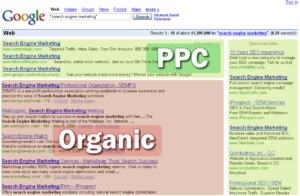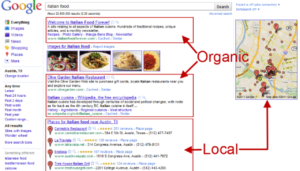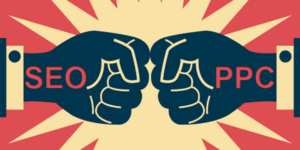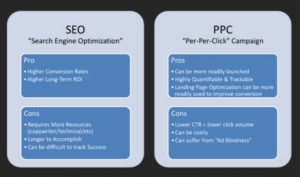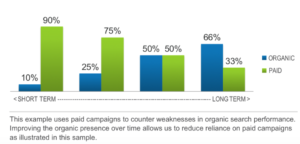Internet marketing can be a tricky business. It takes an incredible amount of data and customization of your content and pages to truly optimize any online marketing campaign. SEM (search engine marketing) requires a fine balance of the right ingredients to solidify the “right recipe” your specific campaign needs to succeed on the SERPs.
So what is the right balance? How do you identify the right recipe for your SEM campaign?
The two major fields of SEM are recognized as SEO (search engine optimization) and PPC (pay-per-click advertising).
The first focuses on increasing organic traffic through optimizing your keywords, content, and site architecture to impress the search engine crawlers and raise your SERP (search engine results page) ranking. Optimizing these different on-site and off-site factors improves your ranking, or where the search engine naturally places your link and increases organic traffic (traffic that is generated by users clicking on your SERP link, instead of advertisement).
The second focuses on paid search and optimizing your conversion rate from the number of people who click on your paid ad. With a combination of Quality Scores, relevancy, and bids, you can optimize your PPC ads to pay less per click and increase the viewership of your ads on the top and right-hand sides of the SERPs.
“We are all Google’s children.”
With Google (and other search engines) continually growing more adept at predicting and customizing the information they provide users, the SEM world is rapidly becoming more complex. The more advanced Google becomes, the more nuanced and sophisticated our SEM campaigns need to be in order to adapt to the way users are finding information.
Isolating your online marketing practices to just SEO or just PPC is essentially cutting off your access to half of the SERP, and limiting your audience to a single method of interaction. In today’s digitally advanced and Google-oriented market, you need a blend of both SEO and PPC practices if you really want to optimize your SEM performance.
As Search Engine Marketers, we are at the whim of Google’s developments – constantly adapting and optimizing our own tactics in response to any new development in Google’s algorithms or any improvement to how they provide and organize information for their users.
So how does we optimize our blended SEO and PPC search campaigns? What is the right ratio of organic to paid traffic? And what are the strengths of each that we should be optimizing? To answer how we need to adapt to Google’s evolution, let’s first look at how Google started us down this long and winding road.
“In the beginning, there was vertical search.”
Think about whenever you type something into the Google search bar. You have the options of picking from the categories: “all,” “images,” “videos,” “news,” “shopping,” “maps,” and so on. These are each, in and of themselves, vertical searches.
Originally Google only functioned with each of these search silos as separate SERPs. With the primary SERP being categorized under “web” instead of “all.” The “web” vertical search would provide you with results like websites and content pieces that were relevant to your search but not categorized as “news.”
These silos made it easier to focus your primary keywords based on the specific Google vertical search your product or service was trying to rank for. For example, if you had a page focused on kittens, you could focus your primary page aroud the keyword “kittens” while using the keyword “images of kittens” or “kitten pictures” to improve your ranking on the Google Images SERP.
Google’s algorithm, which takes into account content quality, relevance, authority, and countless other factors, made keyword optimization the backbone of SEM practices indefinitely.
“Let there be Keyword Optimization!”
So how did keyword optimization work for SEO and PPC back in the days of vertical search? Essentially the same way it does now, though less intermingled.
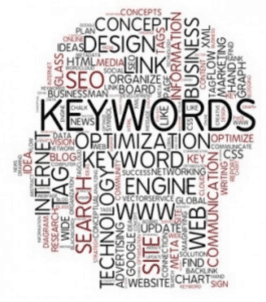
Although they both can be considered the children of Google’s SERP algorithm, keyword optimization for SEO has always been fundamentally different from keyword optimization for PPC. The fundamental difference between the two has consistently been the time-investment necessary in relation to the amount of money necessary in order to see results.
Where PPC ads can yield very quick results because you are paying for your spot at the top of the SERP page, they can be costly and do not always lead to an increase in actual conversions. While SEO focuses on optimizing your site and content to increase conversions (and doesn’t cost you per click), it can take quite a long time to actually improve your ranking on the SERP, so you may end up waiting a while to see the conversions you’ve been promised.
Because of this, PPC was previously the big dog of the SEM game. PPC metrics are easily measured and calculated, not to mention PPC campaigns are very easily adjusted for optimization. If you pay for an ad on Monday that doesn’t seem to be working, you can drop the payment and have a different ad running within the same week. SEO, on the other hand, relies on measuring more abstract metrics such as “quality,” “relevancy,” and content engagement. These more user-centric metrics are very important, but are simply harder to monitor.
However, PPC’s domination of the SEM battlefield was halted when Google decided to change the game all over again with Universal Search and blended results.
“And Google said: ‘I shall give you the universe.’”
As opposed to vertical search silos, Google’s universal search considers the volume of search modifications related to any query, no matter the format, and provides “blended results” on the SERP to account for a more universal mode of search engine usage.

With universal search, if you were to type in “kitten” into the search bar, the blended results SERP would automatically provide you with images of kittens as one of the possible results to your query. Any and all relevant results from your query will appear on a single SERP together, with the option to “specify” your search back into the vertical style. This allows users looking for specific pieces of content to narrow their search to just images, or just news.
An example of a blended SERP for “Italian food”: organic, local, image, &c.
With blended search, the SERP world became exponentially more integrated and complex. SEO instantly became the best way to account for and optimize the relevancy of your pages in order to rank higher on these blended SERPs. Paying for the siloed PPC keywords became oversaturated and bid prices per click started to increase. With such a complex and integrated form of search engine user interaction, the KPI of focus quickly became conversions over traffic.
But on the seventh day, Google did not rest. No, it’s still going, making search engines even more adaptive and predictive to the user’s queries and interests. Now, on top of just universal search, we also have the Knowledge Graph.
The Knowledge Graph is a huge step forward in Google’s initiative in becoming a search engine database built on providing users knowledge, not just information.
The Knowledge Graph takes into account the relevant topics and information related to your query and provides you with a panel to the right of the SERP with the necessary information that others found useful combined with related information from the Knowledge Graph index (see above for the search: Charles de Gaulle”). All of the information in the panel, like date of birth, bio, books, related cities, other historical figures, etc is pulled from different authoritative sites already on the SERP.
This changes the way we have to optimize our SEM strategies drastically. Why? Because Google is providing the users our pages’ information click-free! The bulk of users using Google to answer simple, general questions, are now provided their answers without ever having to click on a single link or ad to take them to another page. Now, what can we do?
“Do not be sad. Optimize.”
In response to an increasingly more universal search engine, we must adapt our SEM strategies to be more universal themselves. Blended results require blended optimization practices. Here is where the recipe comes into play, how can we take the two temptations of SEO and PPC and blend them into one, grand, optimized SEM campaign?
Keyword optimization remains the backbone of any and all SEM campaigns. But customizing your keyword research for an adaptive universal SERP requires the right dash of SEO here and the right dollop of PPC there. Use each tactic to its strength and you’ll be able to dominate the entire SERP instead of just your little corner of it.
SEO keyword research is highly in-depth to make your content more adaptive to the user’s specific queries. Although the Knowledge Graph may be stealing away first dibs for most general information, the long tail keywords are still yours for the taking. The niche user is still going to be looking for specific and detailed information and/or answers on the actual links of the SERP, he/she won’t be satisfied by the brief panel Google has slapped on.
Use your long-tail keyword research to help format your page and your content into incredibly useful information for your users. Don’t settle for being relevant, make your results pertinent in the eyes of the user.
PPC keywords have been pushed out to sea a bit resulting in the developments in universal search and the Knowledge Graph. Shelling out big bucks for ads that show up when a user types in “SaaS SEO agency” or “PPC company” into the search bar just isn’t financially efficient if the majority of those searches aren’t going to convert on your landing page.
Instead, consider using your PPC ads for more targeted, branded search results that have a much higher conversion rate that make them worth the money. When you are paying per click on your ad you want to make sure that each click counts. Don’t get bogged down by putting up ads on the most expensive and popular words just to try to cut out your piece of the pie.
Your SEO keywords should focus on increasing your visibility and engagements, while your PPC ads should focus on converting. The first constitutes more of the upper funnel while the latter should be solidifying the bottom.
“Optimize as you can. Not as you want.”
The biggest difference between organic and paid search campaigns (besides the fact that money is involved with one and not the other) is the time it takes to see results. Developing brand awareness on the search engines isn’t a sprint. But it isn’t a marathon either.
It’s a marathon of weekly sprints. Time is an incredibly important factor.
Developing a viewership is necessary to get any SEM campaign off the ground, and if you are looking to draw traffic to a new landing page, PPC is probably your best way to go. Optimizing your pages for better results that generate organic traffic instead of paid traffic is how you make your PPC campaigns more autonomously effective. This is where SEO takes control of the wheel.
As the above graphic illustrates, your PPC campaign should be used to jumpstart your page’s traffic generation while you steadily develop your organic keyword optimization. Once your SEO tactics begin to bear their fruit, you can use your PPC campaigns to better inform your long-tail keyword research and content marketing roadmaps. Instead of relying on your ads for traffic generation and conversion, you can use them as foundations of keyword research.
Use the metaphor of a professional baseball player as a guideline for how to balance your SEO and PPC campaigns. Where when first learning to swing a bat, a novice ballplayer would have to focus intensely on the fundamentals of the motion and the specific technique. You can conflate this with PPC ads, that focus on the tangible improvements of your ads.
But once he’s developed into a full-fledged professional stud, you’d think it odd if he focused that diligently on his fundamentals. In fact, it’s proven that the more an expert focuses on the minutia of his task, the worse he’ll perform. The “task” at hand here is keyword optimization and developing organic traffic. As your SEO campaign grows more expertise, you’ll want to rely less on your “fundamental” PPC ads to generate traffic, otherwise, it’s just inefficient.
Combining your SEO and PPC campaigns does more than account for the complicated balance of blended SERPs. There are several ways in which PPC research and data can inform your SEO campaigns, and many ways in which optimizing strategies usually reserved for SEO can be applied to PPC campaigns. The truth is that the two work better when blended together than they do when used in isolation.
“Idle pages are the devil’s playthings.”
So we’ve developed the roadmap of Google’s evolution and the blending of paid and organic search along with it. But the balancing act of SEM is like walking a tightrope in between two titans of the industry. How do we know we have the right balance between the two? And what are some common pitfalls that lead to the long plummet down to the bottom of the SERP?
The two major pitfalls that will cause you to lose your balance are, thankfully, fairly easy to avoid. Issues usually arise with a blended campaign due to a lack of communication or a failure to play to either tactic’s strengths.
If you aren’t using either tactic to inform the research of its counterpart, you may very well end up with overlapping keywords that are just burning a hole in your pocket. Or, worse than that, you may be using SEO tactics on branded keywords that you could be capitalizing on far quicker with PPC ads.
Or, even worse than that, you might be paying for PPC ads that aren’t converting at which you could abandon and replace with keyword optimization to boost your ranking instead. Playing to the strengths of each individual factor is the key to any blended recipe. Don’t mix up the salt and pepper.
“Reclaim the SERP: Deus Vult!”
Accounting for two very different online marketing campaigns makes for quite the balancing act, that’s a given. But knowing what KPIs to look for and what strengths to emphasize in your paid and organic search campaigns will make optimizing both for universal search far more natural.
Playing to the strengths of the two children of Google’s search engine is the best way to take on the original Titan. Take back the authority your pages deserve by tackling the ever-changing Google monster with the two weapons that were born of the sole need to adapt to it. The future of SEM is surely an evolving one, but using PPC and SEO as brothers who help one another where the other falls short is the best way to usurp their father.
Turn the conflict into collaboration, and you’ll be doubling your conversions sooner, rather than later. To practice the fine art of SEM is to adapt constantly, Google wills it!
-
 CEO
Garrett Mehrguth
CEO
Garrett Mehrguth
Did you enjoy this article?
Share it with someone!

